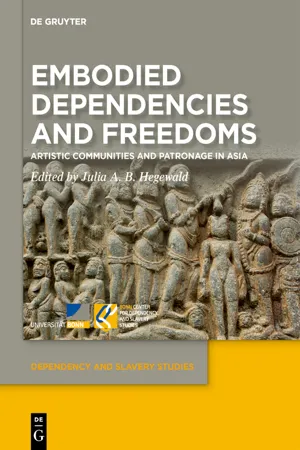
Embodied Dependencies and Freedoms
Artistic Communities and Patronage in Asia
- 463 pages
- English
- ePUB (mobile friendly)
- Available on iOS & Android
About this book
Have you ever thought about dependencies in Asian art and architecture?
Most people would probably assume that the arts are free and that creativity and ingenuity function outside of such reliances. However, the 13 chapters provided by specialists in the fields of Asian art and architecture in this volume show, that those active in the visual arts and the built environment operate in an area of strict relations of often extreme dependences. Material artefacts and edifices are dependent on the climate in which they have been created, on the availability of resources for their production, on social and religious traditions, which may be oral or written down and on donors, patrons and the art market. Furthermore, gender and labour dependencies play a role in the creation of the arts as well. Despite these strong and in most instances asymmetrical dependencies, artists have at all times found freedoms in expressing their own imagination, vision and originality.
This shows that dependencies and freedoms are not necessarily strictly separated binary opposites but that, at least in the area of the history of art and architecture in Asia, the two are interconnected in what are often complex and multifaceted layers.
Frequently asked questions
- Essential is ideal for learners and professionals who enjoy exploring a wide range of subjects. Access the Essential Library with 800,000+ trusted titles and best-sellers across business, personal growth, and the humanities. Includes unlimited reading time and Standard Read Aloud voice.
- Complete: Perfect for advanced learners and researchers needing full, unrestricted access. Unlock 1.4M+ books across hundreds of subjects, including academic and specialized titles. The Complete Plan also includes advanced features like Premium Read Aloud and Research Assistant.
Please note we cannot support devices running on iOS 13 and Android 7 or earlier. Learn more about using the app.
Information
Table of contents
- Title Page
- Copyright
- Contents
- Preface
- Chapter 1 Introduction: Embodiments of Dependencies and Freedoms in Asian Art
- Chapter 2 Climate and Resource Dependencies in Buddhist Art and Architecture along the Northern Silk Road
- Chapter 3 Temple Architecture in Coastal Karnataka: An Interplay of Climatic Dependencies and Artistic Freedoms
- Chapter 4 Chinese Export Porcelain of the Ming Dynasty and its Dependence on Foreign Silver
- Chapter 5 ‘Slaves of God’: Extreme Religious Dependency in Medieval South India (800–1100 CE)
- Chapter 6 Usages and Instrumentalisations of the Sanskrit Term ‘Dāsī/Dāsa’ (Servant-Slave) in Pre-Colonial and Colonial South India: The Case of the Devadāsīs and Rājadāsīs
- Chapter 7 Mediating Śakti: Embodied Dependencies and Senses in Teyyam, Malabar, South India
- Chapter 8 Patterns of Dependency in the Buddhist Tantric Iconography of Nepal
- Chapter 9 Dependence and Freedom in the Theory and Practice of Indian Temple Architecture
- Chapter 10 Bound by Tradition?: An Investigation of the Extreme Dependency of Artists on Un-written Artistic Conventions for Dance Imagery in Sculpture and Painting
- Chapter 11 Dependencies and Artistic Freedom in the Context of Himalayan Conservation Projects
- Chapter 12 Countering Cerebral Invasions: Sculptors Against Dependencies
- Chapter 13 The Story Tellers of Mysore: Regime Change and the Musarrati Performance Artists of Tipu Sultan’s Court
- Chapter 14 Indigenous Modernities in Dependent Princely States: Design of Public and Civic Spaces in Baroda
- Glossary
- Index